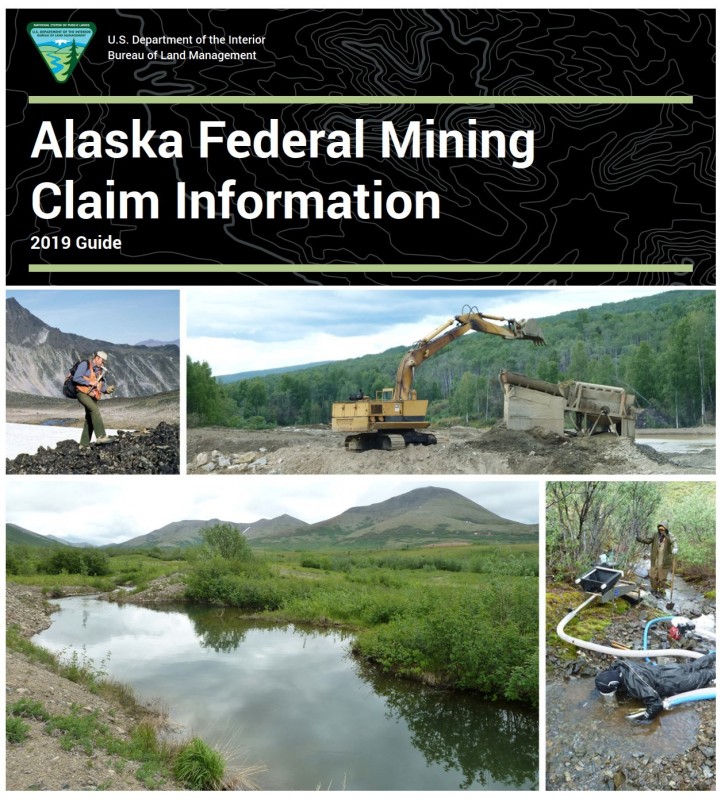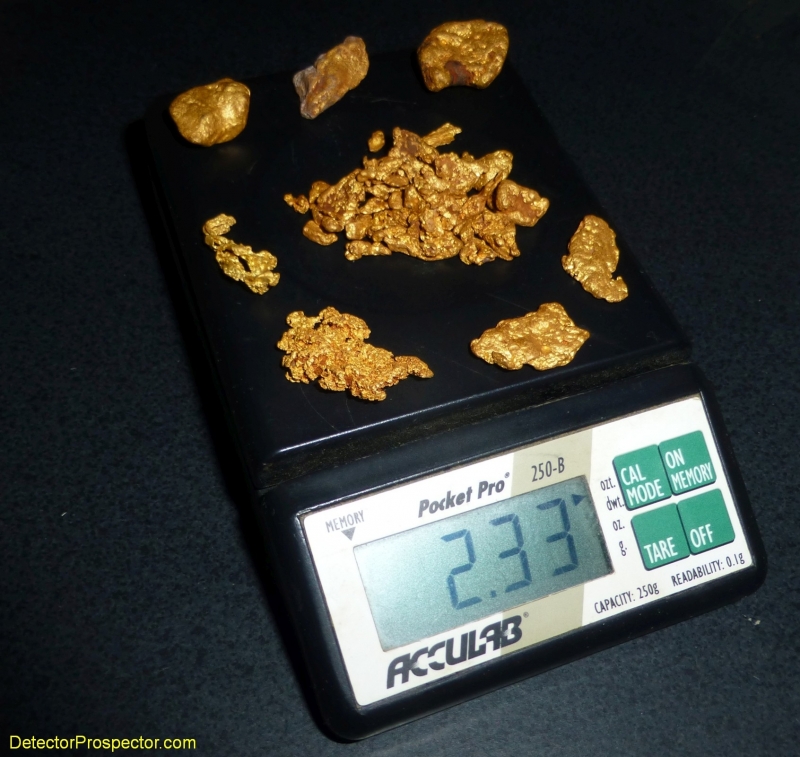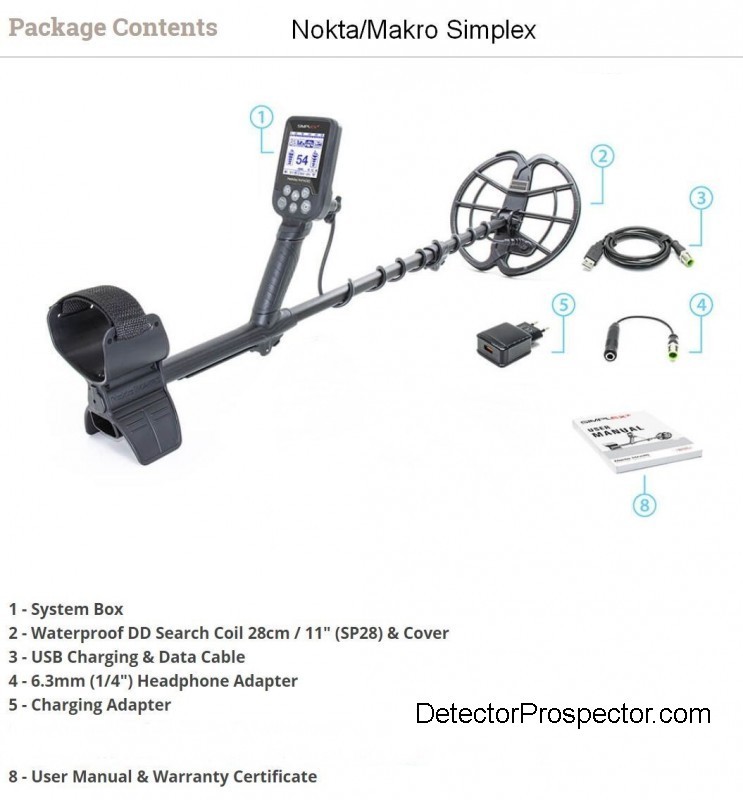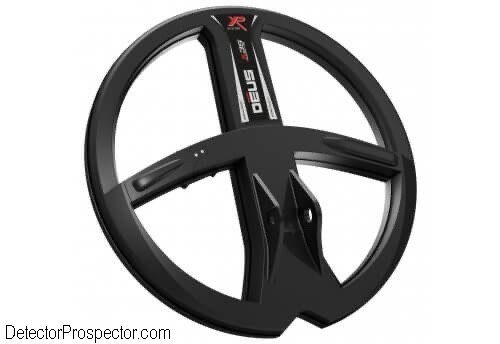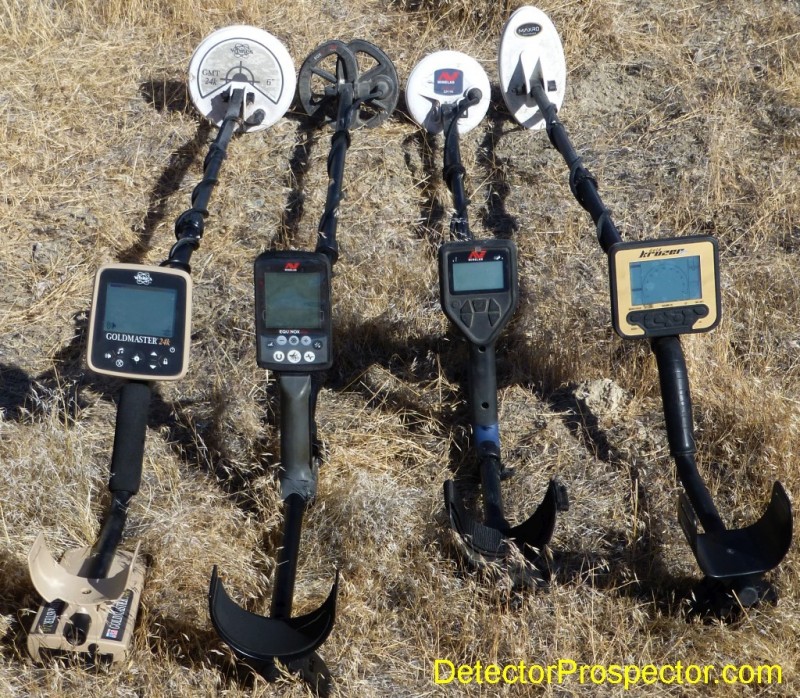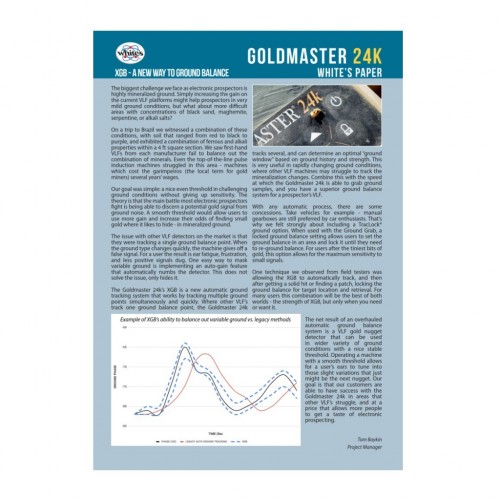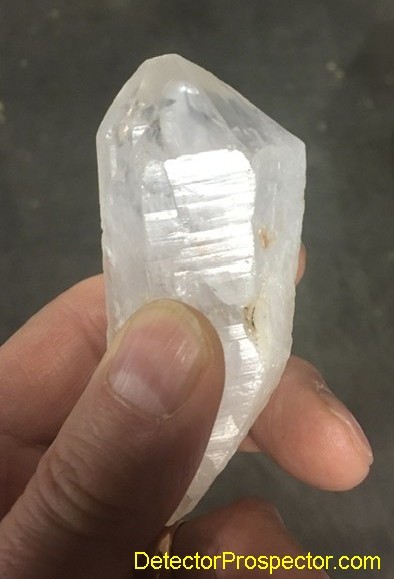-
Posts
19,761 -
Joined
Content Type
Forums
Detector Prospector Home
Detector Database
Downloads
Everything posted by Steve Herschbach
-
First place I would try: Keith Wills East Texas Metal Detectors 1495 Fm 49 Gilmer, TX 75644-4363 (903) 734-7773 http://www.brokendetector.com/
-
While I am at here here is a link to the new ALASKA FEDERAL MINING CLAIM INFORMATION 2019 GUIDE. This is an updated guide from the 2015 version and includes the latest fees, forms, and dues dates. Fees have been updated in July 2019. Alaska Federal Mining Claim Information 2019 Guide (format PDF / 4 MB)
-
No right or wrong, it purely depends on the situation. Are you trying to find a new patch, or trying to extract gold from a known patch? Are you hunting a natural gold patch, or highly disturbed ground like tailing piles? If I am hunting a known patch I am like Lunk, crazy methodical slow. My normal mode is to hunt a week at a time, on one location, basically not moving at all. I find most people can't stand this and want to run all over the place or hop in the car and go someplace else after a day. Not me, just leave me in one place for a week, as long as I know there is gold there. The old saying is "never leave gold to find gold" and as a rule I find it to be good advice. But put me in Alaska hunting tailing piles looking for lost over-sized gold and it is all about ground coverage. The nuggets are few and far between, not in a limited area like a natural patch. And miles of ground usually. Low and slow is not the way to go. If you are hunting for a new patch in a desert, better have a large coil and cover ground like no tomorrow looking for an indicator nugget. Low and slow is no good in 100 square miles of desert. Patch hunting versus known patches, real world result. I spent exactly a month of hunting days in Australia, with JP putting me on a known patch every day. Dawn to dusk. I was in Australia to find an Australia sized nugget, you know, the fist sized type. I figured the pounded patches were not a good bet for that, and so I devoted dawn to lunch each day on a long loop swinging an 18" coil on my GPX 5000. I don't take breaks, I swing for the 4-5 hours I have. I covered about 5 miles per half day on each of those loops. Then after lunch it was hit the patch low and slow. At the end of the month I had 2.33 ounces of Aussie gold. If I recall correctly, like one or at most two of those were found on my exploration trips. I would have bet, did bet, that I would have found some tiny patch or stringer of gold somewhere off the main patch locations. Instead I essentially wasted half my trip for basically no result. I can't say I regret that - go big or go home - and I do have to learn some things for myself. But in retrospect I could have easily have doubled my gold take just by staying on the patches. And frankly maybe got a whisper that proved to be the big nugget I was after. If I go back to Australia again, unless it is specifically a trip to find new ground, I would stay on the patches 100% of the time and give it my all. If I have done that last trip I would probably have found 5 ounces instead of 2.33 ounces. 2.33 ounces of Australian gold I do quite a bit of wandering in Nevada, and have found quite a few isolated nuggets, which apparently are far more common in Nevada than Australia, or at least where we were in Australia. Just one nugget, then hunt there for two more hours and nothing else. And I did find a little virgin mini patch once that gave me about an ounce of gold. But more normal was one week I spent in a gold bearing region but not on a known patch, just hunting dawn to dusk trying to find that fabled virgin patch I know is out there someplace still. A solid week, one nugget of a couple grams. Man I was excited when I found it, but once again it was a one off. It is very hard to patch hunt like that knowing you can drive a few miles and be on gold. But if you want to be that person who really, and I mean really scores, you have to give it a go every once in a while. But realistically, getting on known producing ground with the absolute best machine possible and hunting as slowly and methodically as is humanly possible is what puts gold in the poke these days. Unless you are in tailing piles in Alaska!
-
Honestly, when I hear reports like this, the first thing I think if it is a machine related issue is “bad coil”. The weak area to this day with metal detectors is coil variations that cause issues that people attribute to the detector itself. It’s an almost impossible area to nail down unless people have a duplicate coil available to swap out. I have to hope it’s less an issue with newer machines on modern production lines, but most manufacturers still have people laying windings into housings by hand. On older detectors coil variation was always the dirty little secret in the industry.
-
Nope, not even close. I don’t believe it will happen normally with a properly operating Equinox. It is not impossible that the right combination of ground and multiple targets under the coil could produce such a result, especially if the dime is on edge, but I’m betting you can’t get a dime to read single digits. Best Software Version Test I Have Seen
-

My First Big Equinox Find: 34.9 Gr. 18k Bracelet
Steve Herschbach replied to cjc's topic in Minelab Equinox Forum
Wow, now that’s an awesome jewelry find Clive, and over an ounce of gold in one find! That’s beats the heck out of most nugget detecting and were it nugget detecting would put you in the “one ounce club”! Was a sad loss for somebody. I can’t believe anyone would wear something like that with that sort of clasp into the water. But some people have way more money than I do... and want everyone to know about it. What would we do without folks like that? -
Welcome to the forum, that is some really nice gold Cristian! Your question has been asked and is being answered here for any who want to add to the discussion.
-
We are talking a waterproof detector with rechargeable battery and wireless built in for less money than I have paid for some detector coils! I still find that stunningly amazing and find the ho hum responses of people on some forums just as amazing to me. I guess they simply have not been in this game long enough to realize how long it was that we kept getting charged more, then more, then more for detectors. Just the opposite of all other consumer electronic devices. The Minelab GPZ 7000 was introduced at $9,999!!!!! Just three years ago a Fisher F75 Ltd was $1099... now it’s $699. How long will that last? Finally that dam has burst and we now have true price competition. That’s what really makes Simplex+ a ground breaking detector. It’s just a great performing VLF like dozens of others, that’s not what it’s all about. It’s the feature list and price that is stunning... to me at least. People keep comparing it to detectors costing two or three times more. Get real. Look at what else you can get right now for under $300: Bounty Hunter Land Ranger Pro $256 Garrett Ace 300 $254 Fisher F4 $299 Minelab X-Terra 305 $259 Teknetics Gamma 6000 $299 White’s Treasuremaster $279
-
The Minelab Equinox 800, if you learn it, is the best “do everything” option. That is the machine I personally use for coin, relic, jewelry, and gold nugget detecting. It will outperform the AT Gold on both small and large gold, and is waterproof. For best performance on small gold I recommend the small accessory coil featured in the link below. For large nuggets the Equinox with 15” coil in multifrequency on mild to moderate ground will outperform virtually all VLF alternatives. https://www.detectorprospector.com/forums/topic/7468-my-tips-on-nugget-detecting-with-the-minelab-equinox/
-
Both the Minelab Gold Monster and White's Goldmaster 24K have performance close enough that I consider them roughly equivalent and I am happy to use either. I would recommend either as a performance upgrade to the AT Gold if nugget detecting is the sole intended goal. Both pack more power on both small and large gold than the AT Gold. The choice should be made on the scales of simplicity versus adjustability plus your local price and service options. The Monster is made with as few controls and adjustments as is possible, whereas the 24K has more control options than most nugget detectors. The Monster may seem constraining to some and the 24K too complicated to others, so I recommend looking at the owners manuals for both at the links above when making the decision between them. A note on the Goldmaster weight. Absolute weight is not as important as balance, and the 24K although it weighs more it creates less arm strain in long term use than lighter nose heavy models. This is because the battery box under the arm offsets the coil weight, eliminating the torque created when swinging detectors that are nose heavy. Gold Nugget Detector Guide
-
You could ask this Aussie. I've learned to never put words in an Australians mouth!
-
Unless I’m finding them and you are not! I’ll toss you a bone here Jim and say I sold my Gold Monster and kept my 24K. Why? For the simple reason I noted. I like control options and the 24K gives me that. By the way your comments about ground balance time on another forum are inaccurate however. My Monster took a few pumps/seconds max, not enough difference between it and the 24K to matter in my experience. Oh, and the 24K slays the Monster for ergonomics, hands down, no comparison. Heck, it even comes with an adjustable length rod, will wonders never cease! Shootout anyone? White's Goldmaster 24K 6" concentric coil, Minelab Equinox 800 6" DD coil, Gold Monster 1000 5" DD coil, Makro/Nokta Gold Kruzer 4" x 7" DD coil
-
-
Le Jag posted this on a french forum: Hi, I do not have much news ... the beta testers' returns are excellent, especially on volcanic sand they have detected a problem of electrolysis on the coil connector due to the strong pulse current the connector has been changed to prevent this the battery has been changed to face the future standard for air transport ... what is still dragging are the headphones FTP considers that the gray ghost that was planned in the package is too expensive so they look for an alternative, probably the koss ... and still no date of release: - / Sounds like a detector with plenty of stuff being worked on still. Funny headphones are an issue. FTP makes underwater detectors already. Anyway, next year folks.
-
Higher frequencies will produce the best air tests on all gold targets. However, higher frequencies also react more to the ground and hot rocks. Lower frequencies lose some "depth" in air tests, in particular as regards the smaller targets. However, lower frequencies are also less reactive to the ground and to hot rocks. This means that lower frequencies can be of benefit for a VLF detector in severe ground and hot rocks. You basically give up some theoretical gold sensitivity in return for less reactivity to the ground and the hot rocks. If the ground is so bad it makes the higher sensitivity machine unusable this is a decent trade. You will still do ok on the larger gold, leading to some misunderstanding that lower frequencies are better on large nuggets. Well, sort of, but generally only in very bad ground. Keep in mind most gold is small so going low frequency just to chase large gold is not the best strategy. If that is the idea, get a PI detector. I suppose if you were on a tight budget trying to hunt large gold in very bad ground a low frequency VLF would be a possibility, but a White's TDI SL is an affordable and better PI option for such situations. It’s not a black and white answer type thing though. I could see a lower frequency VLF being the better option over a PI in a high mineral/high trash area. You did not mention but it seems like you may be wanting the detector for more than just gold nugget detecting. If that is so, general purpose lower frequencies like 12 -19 kHz are better options. If you are in a park you do not want extreme sensitivity to all the zillions of bits of tiny trash. General purpose machines are purposefully "less hot" for that very reason. If you actually want a general purpose machine that is a whole different can of worms I will ignore for the time being in favor of the original question. I will point out that your mention of the Equinox as a "lower frequency" machine is not entirely accurate since the 800 runs up to 40 kHz while also offering low frequency options. Both the Minelab Gold Monster at 45 kHz and the new White's Goldmaster 24K at 48 kHz target that frequency range for giving the best balance of performance of the type of gold most U.S. prospectors are likely to encounter in quantity, especially now that most areas have been pounded with PI detectors. I wish I could tell you a low frequency VLF is a great option but it’s this basic truth we all have to deal with - the big nuggets get found first and PI blows VLF away in that regard. The Gold Bug 2 at 71 kHz is the reigning master of tiny gold, but pays the price in poor penetration in bad ground. The real benefit however is both these newer machines are employing the very latest in digitally processed ground balancing that allows them to better work in ground where such high gain machines would previously have had more difficulty. This does not mean they equal PI detectors in that regard, as some people incorrectly assume. It's just that they do as good as machines in their class can do handling bad ground. Both the Minelab Gold Monster and White's Goldmaster 24K have performance close enough that I consider them roughly equivalent and I am happy to use either. The choice should be made on the scales of simplicity versus adjustability. The Monster is made with as few controls and adjustments as is possible, whereas the 24K has more control options than most nugget detectors. The Monster may seem constraining to some and the 24K too complicated to others, so I recommend looking at the owners manuals for both at the links above when making the decision between them. White's Goldmaster 24K Advanced Ground Tracking Explained
-

Neil Jones Beach To Land :-(
Steve Herschbach replied to Relics&Bones's topic in Minelab Equinox Forum
Hey Terry, great to hear from you, hope you are doing well. I miss Hawaii, been too long but no plans at all right now for a visit anytime soon. Here is another related issue... the differences between all of us as regards not only experience levels but true hard wired brain differences. This is a fact. Two “experts” running the same detector in the same location can come up with two very different combinations of settings. They can both do just as well making finds, and each could try but not like the other persons settings. I tend to run hot to the point of instability (noisy) and I prefer 50 tones. Another person may lean to stability and quietness, so maybe lower sensitivity and a preference for two tones. This is not without good reason. My method generates more signals which requires a lot of mental processing which can be tiring and I may miss targets as a result. I may also get targets the other person can’t hear at all since their machine is running at lower levels of sensitivity. It’s a trade and neither method is correct, you will find proponents on both sides of that debate. Our ears and our brains truly are wired differently and what works well for one person simply may not work well for the other. -

Neil Jones Beach To Land :-(
Steve Herschbach replied to Relics&Bones's topic in Minelab Equinox Forum
All I can say is I have no use for or any interest in canned programs or other peoples settings. I learn my controls and set my machine as seems appropriate for my location and personal preferences. If one combination of settings worked for everyone, we would not need the controls. Minelab could just dial in the appropriate settings and just have an on/off switch and maybe a sensitivity control. In trying to do this Minelab came up with 8 separate programs or presets showing that one size can't fit all. The Equinox presets however in my opinion are among the very best designed for any detector, and the farther you get from the preset adjustments the less happy you are likely to be. -

How To Get A 7" X 10" Coil For Your Equinox
Steve Herschbach replied to Steve Herschbach's topic in Minelab Equinox Forum
My original post was tongue in cheek and designed to get feedback and responses that Minelab will probably see. I really don’t think Minelab has a clue how much ill will their current coil strategy generates. -

Change Of Coils Changes Bottle Cap Tone Break
Steve Herschbach replied to kac's topic in Metal Detector Advice & Comparisons
It’s a very well known difference in concentric versus DD which is why old timers seek out machines that can employ concentric coils. Coil Basics by Carl Moreland About Search Coils by Dave Johnson Search Coil Field Shape by Dave Johnson From the second article above “The advantages of the DD are greater depth in mineralized soil, a broad sweep pattern, and narrower target response. Its primary disadvantages from a user's point of view are multiple responses on shallow targets and poor discrimination of flat iron objects.” Emphasis added. -

Strange Rocks Identification
Steve Herschbach replied to Thamil9897's topic in Rocks, Minerals, Gems & Geology
It appears to be voids or vugs in a fine grained layered sedimentary rock of some sort. I’ve seen similar, nothing to get particularly excited about, but unusual. If you have a university geology department nearby or a rock club they can probably give you more information. http://downloads.wvgs.wvnet.edu/pubcat/docs/FTG-9_WVGES-ESAAPG17_FieldTrip_US48-CorridorH.pdf -

Old Diggings At Rye Patch With The Gpz-7000
Steve Herschbach replied to Gerry in Idaho's topic in Detector Prospector Forum
Rye Patch is known for many large and at times quite spectacular quartz crystals found while wandering around. Gerry’s is a particularly fine specimen with excellent form and sharp features. Here is a lesser quality one I found, and a link to some more pictures. https://www.tapatalk.com/groups/nevadanuggethunters/rye-patch-quartz-crystals-t592.html http://www.billandlindaprospecting.com/peglegjohn2.html -
The Garrett ATX and Minelab GPX 4800 have similar capabilities, and unless I needed the detector to be waterproof (ATX) my choice would be the GPX 4800. It has more power, more tuning options, and vastly more coil options at better prices.
-

Old Diggings At Rye Patch With The Gpz-7000
Steve Herschbach replied to Gerry in Idaho's topic in Detector Prospector Forum
Eh, we see gold all the time - nice crystal! You did well Gerry.

